What to Look For In A Pressurized Alcohol Stove
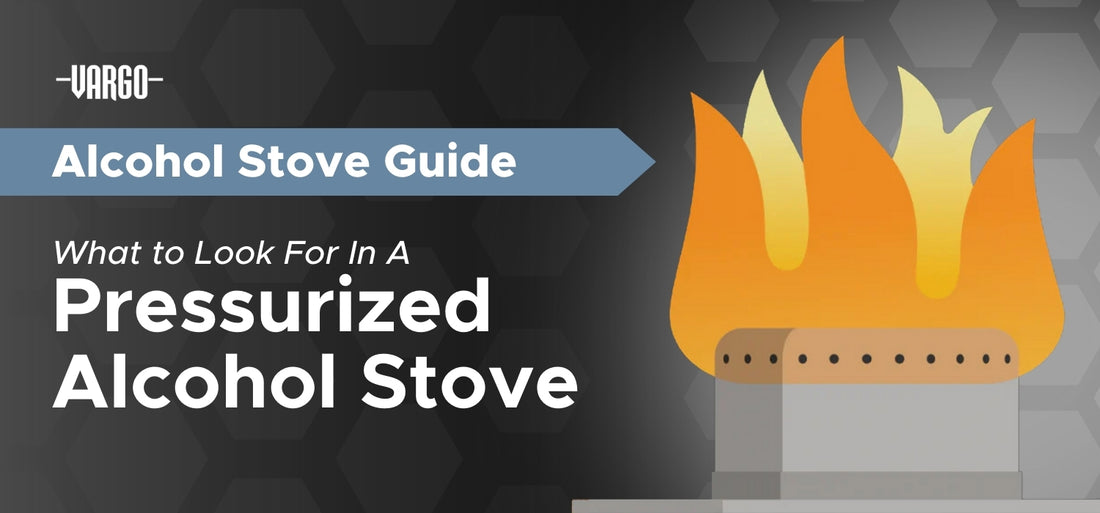
Backpacking stoves have evolved from traditional liquid petroleum models to modern canister stoves using isobutane. Nowadays, many opt for alcohol stoves for their simplicity, lightweight, and eco-friendliness.
These stoves are a great choice for backpackers, campers, and outdoor enthusiasts looking for efficient and environmentally conscious options. Explore more about the benefits of alcohol stoves for your outdoor adventures and the unique advantages they provide backpackers, campers, and outdoor enthusiasts.
How Alcohol Stoves Work
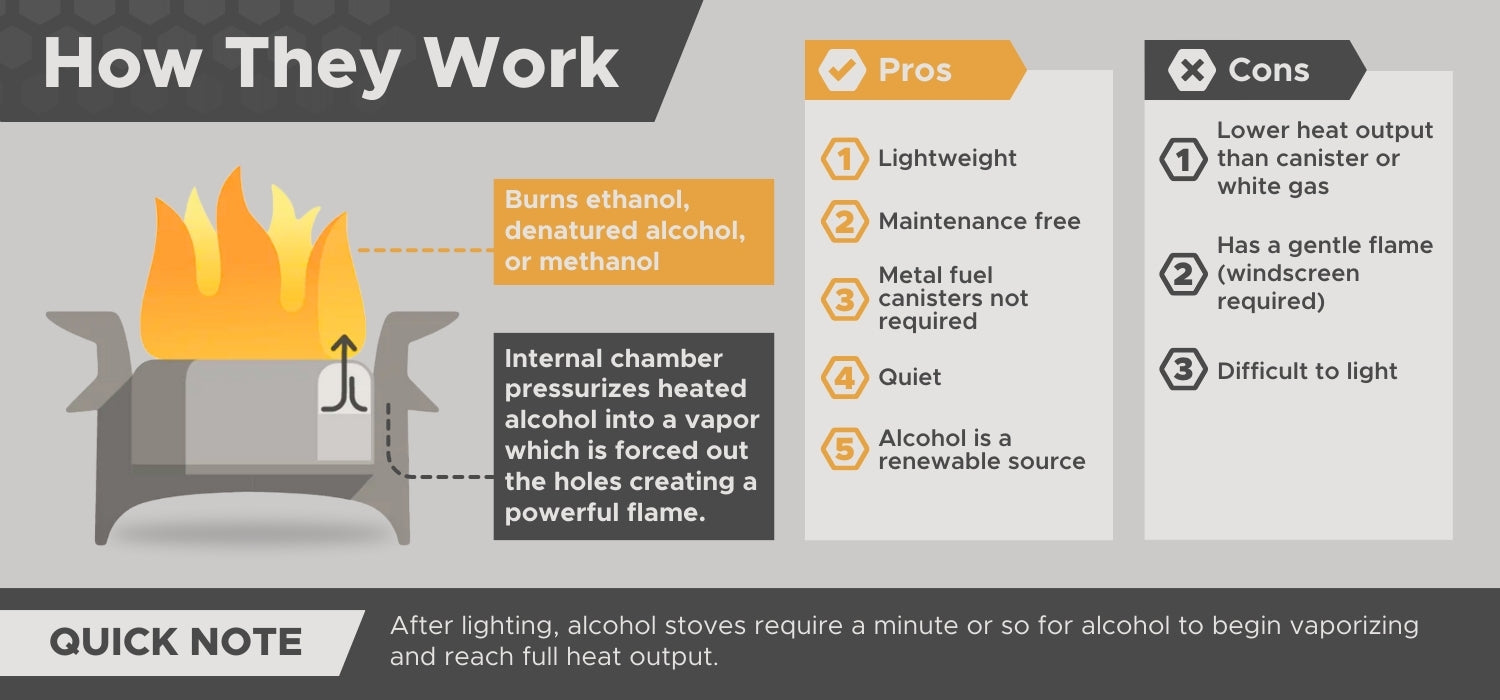
Alcohol stoves burn different varieties of alcohol, namely: ethanol, denatured alcohol, or methanol which are all readily available at hardware stores and many gas stations.
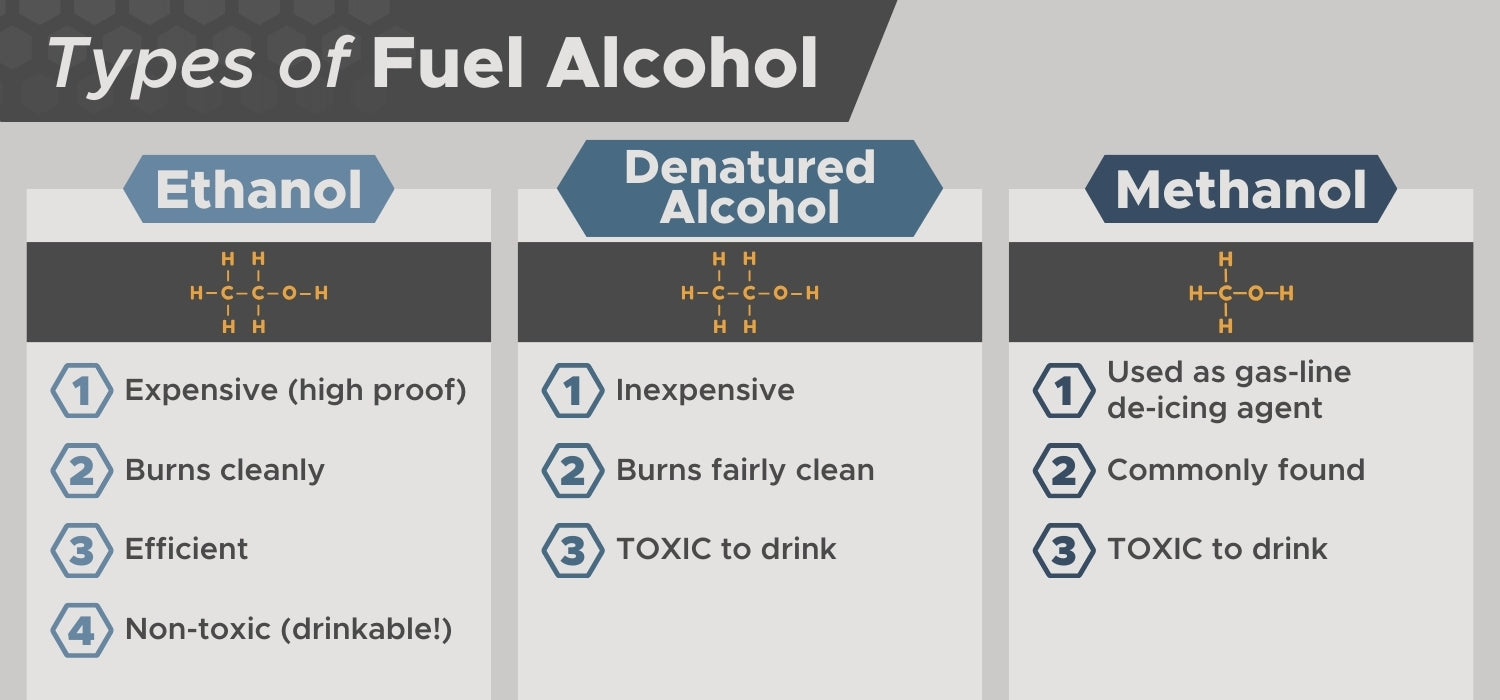
- Ethanol (drinking alcohol). The most expensive fuel alcohol is high-proof (greater than 190) ethanol. It’s expensive, but it burns cleanly, with little soot or aroma, is very efficient, and is non-toxic. Bonus: You can dump excess stove fuel into your drinks!
- Denatured Alcohol. Inexpensive, this is mostly ethanol with a toxic chemical added to denature it—which makes it unsuitable for drinking. It’s sold as stove fuel or solvent and burns fairly cleanly. Though it may resemble drinking alcohol, it is TOXIC to drink.
- Methanol (wood alcohol). It’s often sold in a slim yellow bottle as a gas line de-icing compound at hardware stores and gas stations. It is furiously toxic when ingested, though.
Most alcohol stoves are simple. They mostly consist of two different parts:
- A metal container into which the alcohol is poured
- An internal pressurizing chamber from which there are small holes or jets through which the vapor passes out, ignites, and then burns.
Variations in the shape and configuration of the stove offer different advantages and disadvantages.
PROS
- Ideal for long-distance hiking: Light and simple
- Easy to carry: Uses light plastic bottles for fuel
- Low maintenance: No need for cleaning jets or oiling pumps
- Eco-friendly: Alcohol is a renewable resource
CONS
- Lower heat output: Requires more fuel for less heat
- Sensitive to wind: Needs a windscreen in windy conditions
- Challenging in cold weather: Best suited for three-season use
- Careful handling: Flame is nearly invisible and requires proper ventilation.
Like any open flame, ventilation is essential—and the flame is nearly invisible, so care must be taken in handling the stove, lighting it, and especially when refueling. Most alcohol stoves, like white gas stoves, require some priming—the flame takes a few moments to bloom after it’s lit.
What to Look For
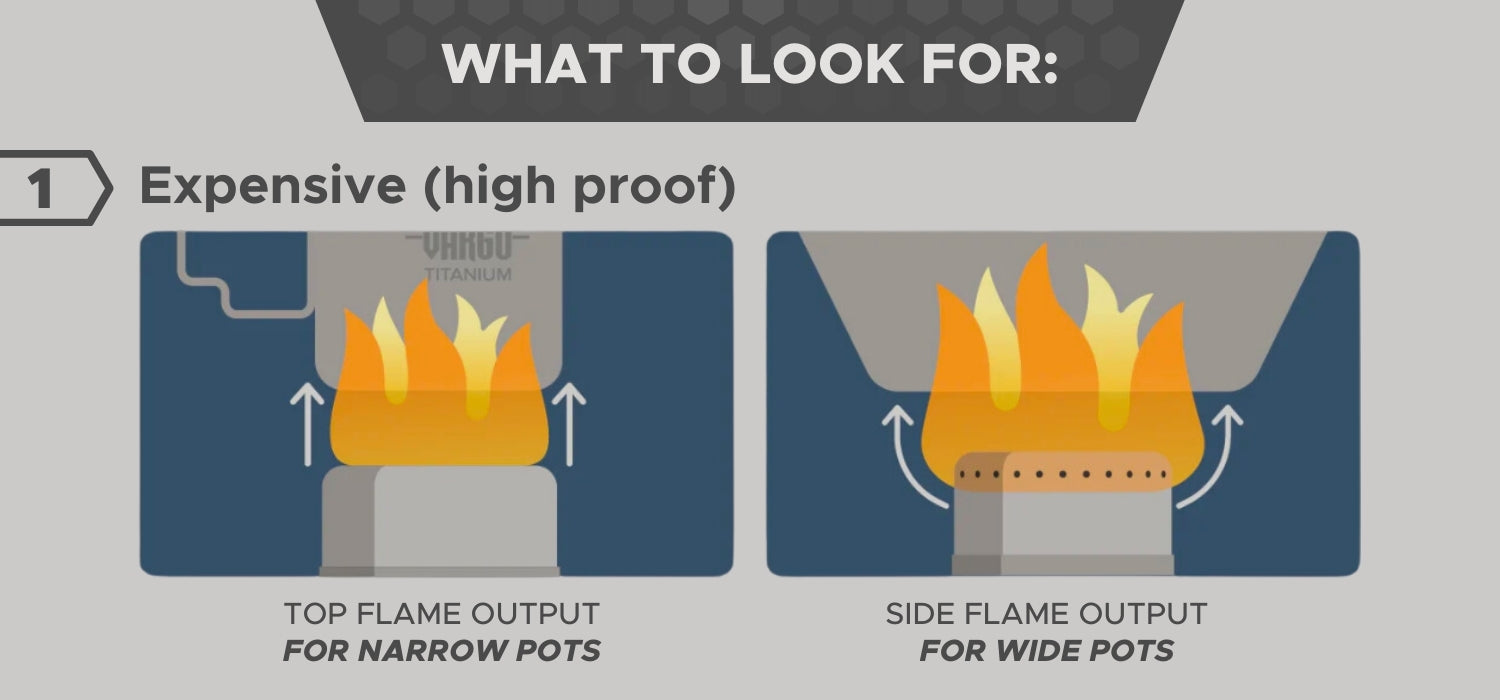
Finding the right alcohol stove can feel like a challenge. Lucky for you, Vargo has the best stoves on the market, and they can be found at major outdoor retailers.
Here’s what you need to consider in an alcohol stove:
Start With the Pot Structure
This may seem backward, but start by deciding what kind of pot you’re likely to use. Short and wide? Tall and narrow? This is critical because different alcohol stoves have different flame patterns.
Stoves with the flame output concentrated in the center will work better for narrower-diameter pots. Stoves with holes on the sides create a wider, more dispersed flame that will heat a wider pot better.
A wide flame on a narrow pot will waste a lot of heat out of the sides, reducing fuel efficiency. A narrow flame on a wide pot could create a hot spot in the center that can burn food.
Picking a flame pattern that matches the width of your pot will ensure the best cooking experience.
Pressurized Burners
Almost every alcohol stove you will see is pressurized. This means the stove has an internal chamber that pressurizes heated alcohol into a vapor and then forces it out through holes. This results in a powerful flame.
Since it burns vapor under pressure, it’s a very efficient system with fast boil times. After lighting, alcohol stoves require a minute or so for alcohol to begin vaporizing and reach full heat output.
Solid Construction

Backpackers need gear that withstands rugged use. It's a wise decision to opt for a lightweight, rust-resistant titanium stove.
If there are any moving parts—like pot supports or stove legs—make sure that the mechanisms are solid. Even better, get a stove that has the pot supports integrated into the stove itself, like Vargo’s Triad Multi-Fuel Stove. The Triad has legs going up to support the pot and legs below to keep it anchored into the ground.
Part of the beauty of alcohol stoves is their simplicity, and many users opt for a stove with no moving parts whatsoever. Vargo’s Decagon Alcohol Stove is a prime example of a stove without any moving parts; compact, strong, and simple, it’s perfect for trips where durability is a key concern.
Stability
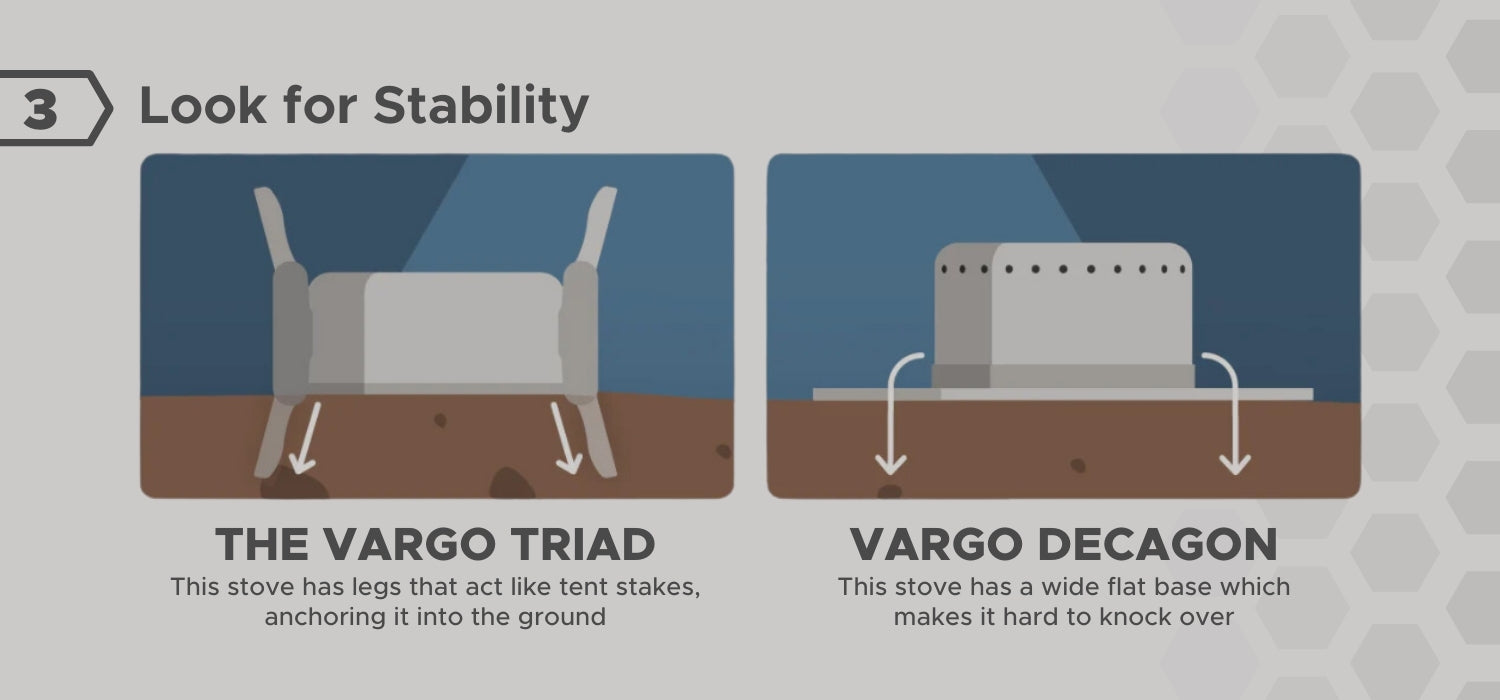
You should choose an alcohol stove with a firm base for safety, especially important due to the open, nearly invisible flame.
Vargo's stoves incorporate tent stake-inspired designs for ground anchoring and pot support. The Triad and Converter have legs going down to stick into the ground keeping it secure and legs going up to support the pot.
For extra security, you can stick those legs into the ground like tent stakes to make sure it doesn’t go anywhere. The Decagon has a flat base which makes it difficult to tip over, and it’s made with a solid top on which you can safely rest your pot.
And always be wildfire-conscious. Place your stove on a stable, level surface. Clear out debris below and around your stove, and beware that local fire restrictions can apply to alcohol stoves.
Easy to Refill
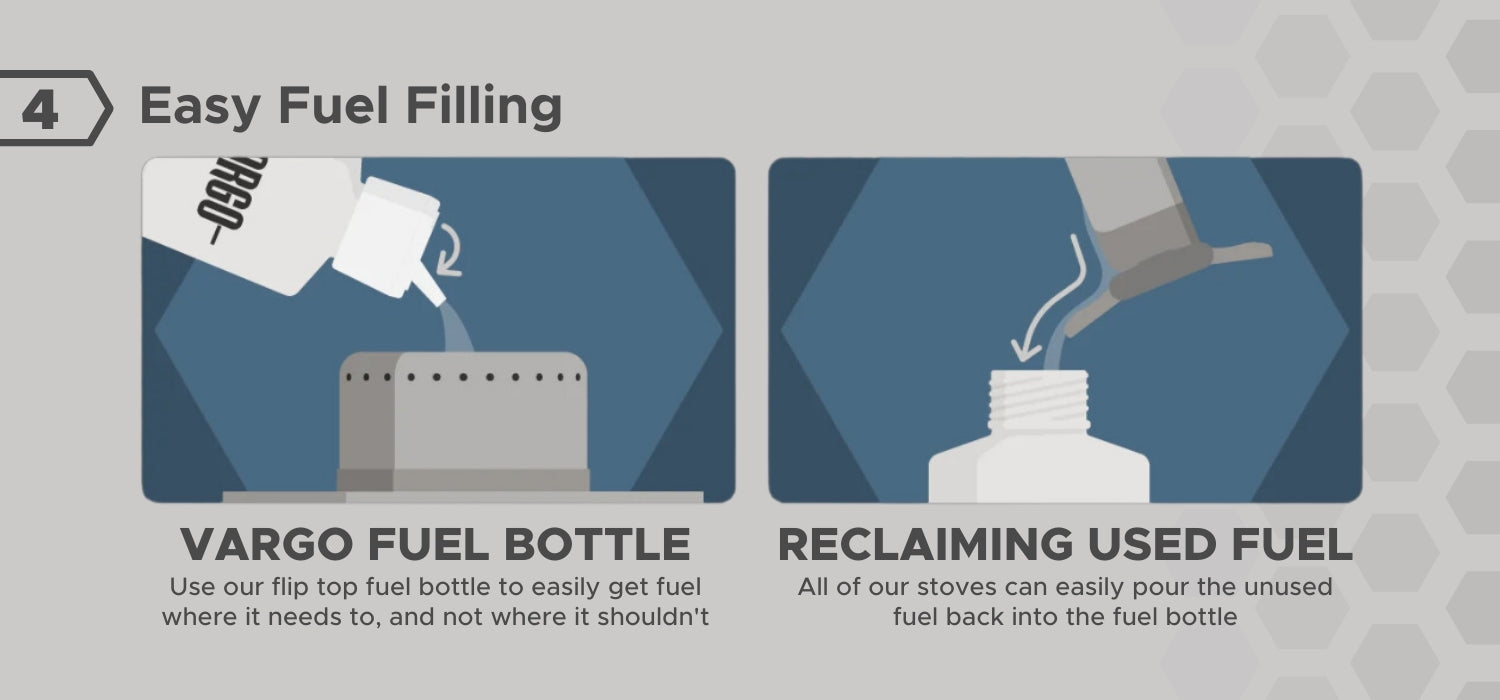
Select a stove with an easy-refill feature. You want to make sure that you can easily get that precious fuel into the stove and not all over the ground, or your hands. Conditions outdoors differ vastly from a comfortable home setting.
The best way to make sure of this is to use a fuel bottle that’s designed for dispensing alcohol fuel. Vargo’s bottle features a flip-top nozzle that dispenses fuel cleanly into the stove, without making a mess and wasting fuel.
Make it easy on yourself and bring the right gear for the job!
Wind and Windscreens
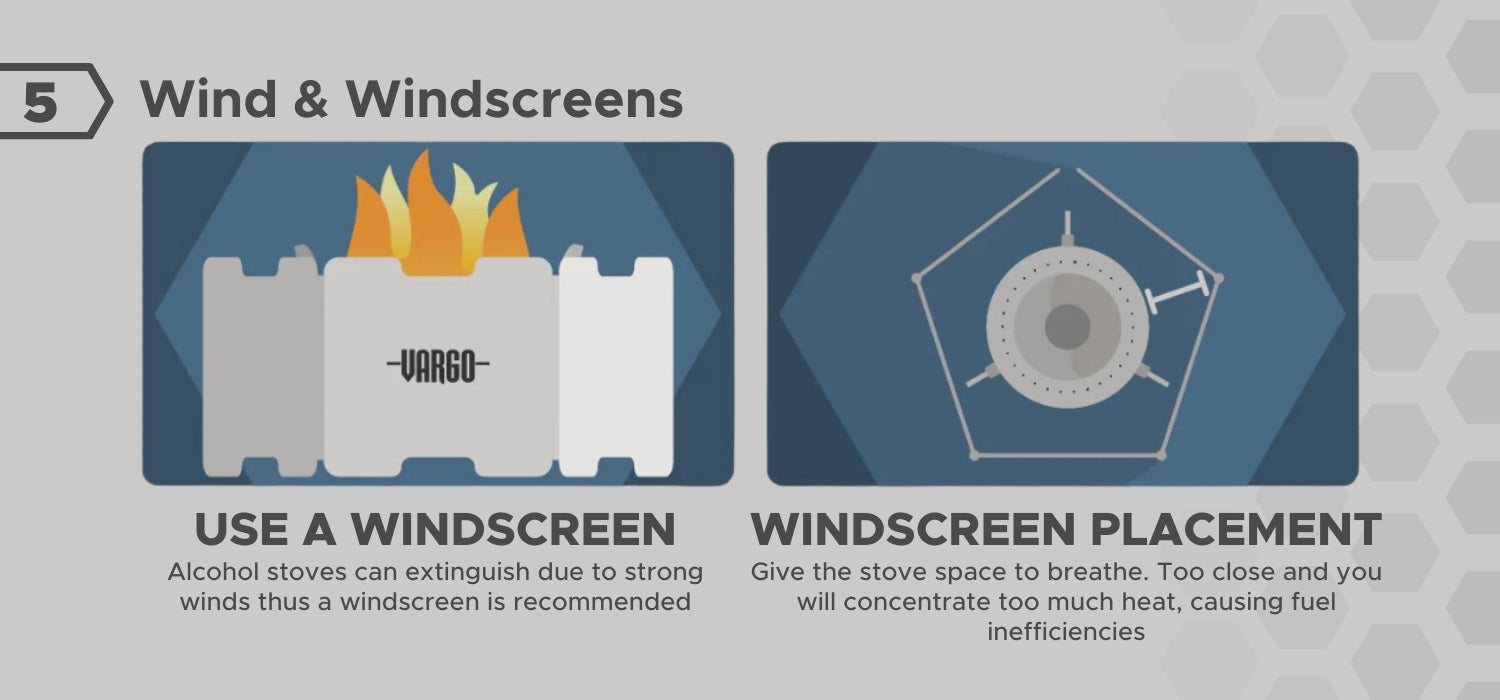
For your stove to work well, you’ll need to protect it from the wind with an effective windscreen. Here's how:
- Ensure there's adequate space between the stove and windscreen for optimal oxygen flow and to prevent overheating.
- You need to allow sufficient oxygen to keep the flame burning optimally.
- If you put the windscreen too close to the stove, you’ll concentrate too much heat within the stove. Rather than helping, this can cause your stove to burn too rapidly and inefficiently.
Vargo’s Aluminum Windscreen is made specifically for their stoves, with a sturdy build and enough ventilation for efficient cooking!
Fuel Capacity and Burn Time
One of the unique features offered by alcohol stoves is their fuel capacity and burn time. Having a larger fuel capacity allows for longer burn times, making it advantageous for extended trips.
It’s important to consider various factors when estimating your required amount of fuel, such as the volume of water being boiled, the type of alcohol used as well as ambient temperature, and stove efficiency.
Calculating How Much Fuel You Need
It is crucial to accurately estimate the amount of fuel needed for your trip. A helpful way to calculate this is by knowing the burn time of your stove, taking into account how many meals and boil times you will need each day.
For example, let’s consider the Vargo Triad Multi-Fuel Stove:
- It can hold up to 1.5 ounces (44 milliliters) of liquid fuel, such as alcohol.
- On average, it provides a burn time of about 20 minutes.
- Boiling half a liter with only 1 ounce (28 milliliters)of alcohol takes approximately three or four minutes.
- This stove also has compatibility with solid fuel tablets for alternative options besides liquid fuels.
By keeping these numbers in mind and making use of both liquid and solid fuels if necessary, you can ensure that you have enough fuel throughout your entire journey without any surprises along the way.
Embrace the Outdoors with Confidence
An alcohol stove for hiking can efficiently meet your trailside cooking needs. Choosing the right stove involves balancing durability, stability, easy refueling, and wind protection.
Equip yourself with a stove like Vargo's, designed to meet these needs, and enhance your outdoor cooking experience. Remember, the right gear can transform your adventure!
Frequently Asked Questions
Are alcohol stoves allowed in national parks?
The use of alcohol stoves is typically classified as an open flame and thus, they are not permitted in national parks. Camping stoves, however, are allowed for cooking purposes.
What is the safest fuel for an alcohol stove?
Bioethanol liquid is the safest fuel for an alcohol stove as it is powerful and clean.
What types of alcohol can be used in alcohol stoves?
Fuel for alcohol stoves can include ethanol, denatured alcohol, and methanol. These three types of alcohol are all suitable options to use in these stoves.
